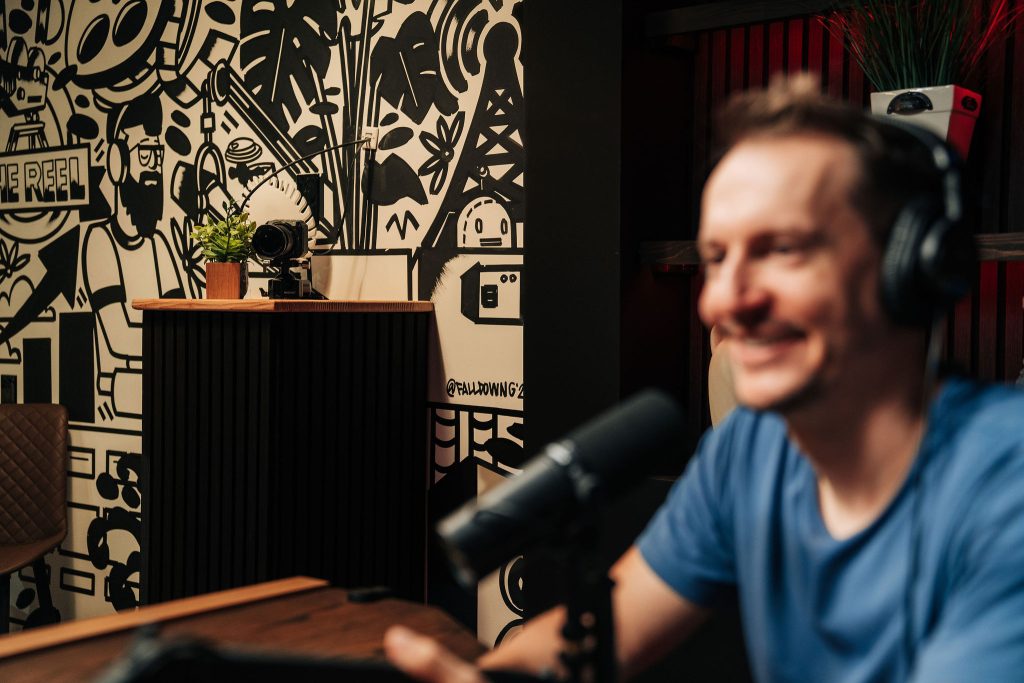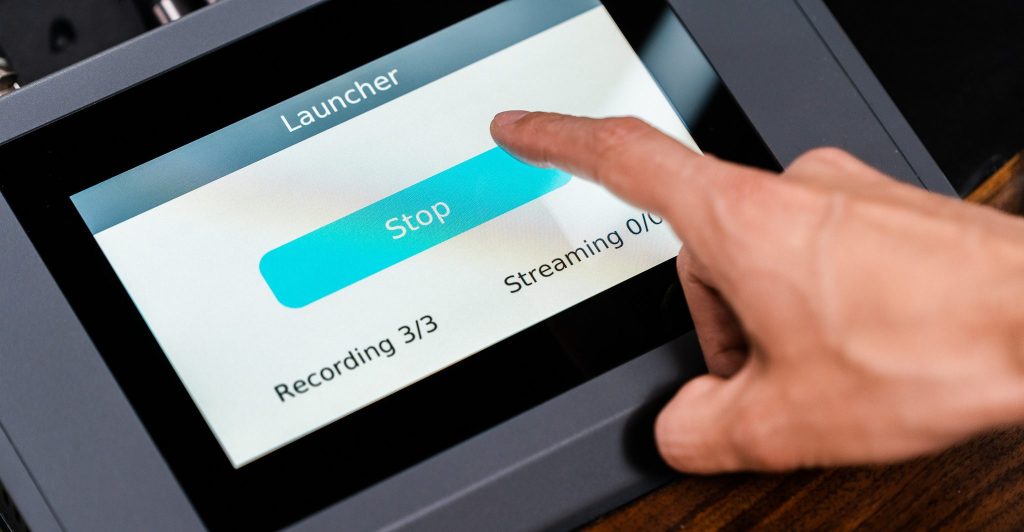Recently, many of our clients asked us what are our best tips to create great podcasts. We decided to share some of the knowledge in the article below, from planning to post-production.
What is the first step in launching your podcast?
Are you familiar with the elevator pitch? Let’s say that you had the idea of the century and you had 30 seconds in the elevator with your CEO. What would you say? Summarizing your vision and intuition into just a few words seems at first impossible, but the moment you have it: you’ve learned what your product is really about. Use that trick for your podcast, and you’ll know how to pitch it, and how to introduce yourself efficiently.
The first crucial step in launching your podcast is to summarize the purpose and approach of your show in less than thirty words. This helps you frame the topic, provide a clear direction, and set boundaries on what you will cover. Having this concise summary from the get-go not only makes opening your show impactful but also keeps you focused on your goals throughout production.
Why Is This Important?
- Summarize the purpose and approach of the podcast in under thirty words: this helps to frame the subject, open the show, and set boundaries on what you cover.
- Choose a hosting platform that allows easy migration to other platforms, saving time. For instance, I use Anchor (by Spotify) for “Le Temps d’une Bière.” From there, I was able to make my podcast available on multiple other platforms. I highly recommend Apple Podcasts, as it is one of the most widely used platforms. At a minimum, I suggest distributing on Spotify, YouTube, and Apple Podcasts.
- Develop a simple, elegant, and attractive YouTube thumbnail template. It’s worth spending several hours on the overall design to save time later and to better align with algorithms. A good thumbnail can increase views by up to a hundredfold. I tested this on my podcast: two hours of work on a single thumbnail increased my views tenfold.
- Create a programming schedule that includes the topics to be covered, the names of guests, their contact information, recording dates, and tentative publication dates. It’s wise to maintain a backlog of episodes ready for release, which can be invaluable if production is interrupted for several weeks.
You don’t need to do all of this yourself. The generative AI revolution has solved many of the problems of content creation. AI is not perfect, but it offers great solutions to optimize and streamline the creation process, and you can save yourself precious time.
Managing Your Time and Your Guests
- Determine a subject and angle for each interview with a guest. For example, if discussing the raw materials crisis, will the focus be on labor, logistics, or a more general overview?
- Conduct a pre-interview with your guest to present your approach, explain the tone you wish to maintain, discuss topics to avoid, provide questions in advance, etc. This also helps build rapport or manage expectations.
- Avoid yes-or-no questions with guests. Open-ended questions are preferable as they encourage conversation.
- The first words are crucial: they need to summarize the show, capture attention, and be concise.Have a sheet of paper with the main points or questions, preferably in order. This serves as both a roadmap and a memory aid. It helps identify a good starting point and provides direction. You can revisit the list of questions if there’s time left. My approach with my podcast is to determine what I want to address at the beginning, where I want to end, and then identify the key points necessary to bridge the two. This gives me flexibility while facilitating the conversation.
- Sometimes an expert might simply say, “I don’t know.” It’s good to ask them in advance to avoid this response or offer an alternative, as it can disrupt the flow of the conversation.
- Provide signals to your guest to manage time, such as extending your hand to indicate there are only five minutes left. This is a way to communicate that time is running out without it being obvious in the podcast. Some people get carried away by their passion and forget how quickly time passes!
2. How Do You Choose The Right Hosting Platform For Your Podcast?
It’s essential to choose a hosting platform that allows you to easily migrate to other platforms, saving you time in the long run. For example, by using Anchor (from Spotify) for “Le Temps d’une Bière,” I was able to make my podcast available on multiple platforms. I strongly recommend including Apple Podcasts, as it is one of the most viewed platforms. At a minimum, ensure your podcast is on:
- Spotify
- YouTube
- Apple Podcasts
Beyond those “Big Three”, there is also a vast network of hosting platforms that can help you spread the word across multiple channels. Below are some of the most popular ones.
- Anchor: Free and user-friendly, with easy distribution to major platforms and built-in monetization options. It’s especially suited for beginners.
- Buzzsprout: Known for its simplicity and excellent customer support, Buzzsprout offers detailed analytics, easy podcast submission to directories, and monetization options.
- Libsyn: One of the oldest hosting services, Libsyn offers a high degree of control over your content, reliable analytics, and flexibility with pricing plans.
What You Should Consider Before Choosing a Hosting Platform
- Ease of Distribution: Look for a platform that simplifies the process of syndicating your podcast to major directories like Apple Podcasts, Spotify, and Google Podcasts. Platforms like Anchor (now part of Spotify) are popular because they automatically distribute your podcast across multiple platforms with minimal effort.
- Flexibility for Migration: Choose a platform that allows you to export your RSS feed easily. This is crucial if you decide to switch hosting providers in the future. A platform that locks you in can be a significant hindrance as your podcast grows.
- Monetization Options: As your audience grows, monetization becomes a key factor. Some hosting platforms offer built-in monetization tools such as sponsorships, listener support, and premium content options.
- Analytics and Insights: Robust analytics are vital for understanding your audience’s behavior and preferences. Look for a platform that provides detailed stats on downloads, listener locations, and platform-specific performance.
3. Invest In Good Thumbnails
The design of your YouTube thumbnail is crucial for attracting attention and being recognized by recommendation algorithms. Spending time to create a simple, elegant, and attractive thumbnail template can significantly increase your views. For example, for my own podcast, I invested three hours on a single thumbnail when I normally spend only 20 minutes. The result was stunning : I increased my views by a factor of ten in the first day, showing just how important it is to pay attention to this visual aspect.
We recommend these online guides:
- 11 killer YouTube thumbnail tips s̶t̶o̶l̶e̶n̶ f̶r̶o̶m̶ inspired by big creators, Tubebuddy
- How To Create a Good Youtube Thumbnail, Wondershare
- 11 YouTube Thumbnail Design Ideas to Catch More Attention, Fotor
4. Everyone Else is Promoting With Reels? How Do I Stand Out?
Before browsing the web in search of the perfect template, remember that you have your own original content to promote. Your original voice is your wedge into the algorithm. The best solution is to hone and refine your storytelling techniques. But don’t worry, we have some tips about that!
There are two ways you can plan for great reels: as you record your podcast and in post-production. The second part is easier, but the first part, is not so much.
I’ve created hundreds of automated reels using Opusclip for one of my podcasts. One thing I noticed about myself is that when I have a particularly compelling anecdote to share, I often find myself falling into rabbit holes—digressing quite a bit before getting to the point. This made it much harder for me to cut original, self-contained stories into effective reels. It would take me forever to deliver something punchy, or editing the pieces back together would consume hours.
As you record your show, be mindful that some stories you tell could make an outstanding clip on YouTube or TikTok, but it’s crucial to speak concisely and stay on point. The rise of the “reel” revolution has dramatically shortened viewers’ attention spans, so delivering your message quickly and is more important than ever.
- A thought-provoking question to start with
- Insightful advice on your market
- Introduce an unexpected problem you fixed for others
- A feel-good conclusion
That said, story-telling is not all there is not it. Great visuals are essential. For this bit, you will enjoy our automated, futuristic studio space with futurist LED lights. Easily cycle through our selection of 7 different colors for a series of reels and inject some of these surreal vibes into your content!
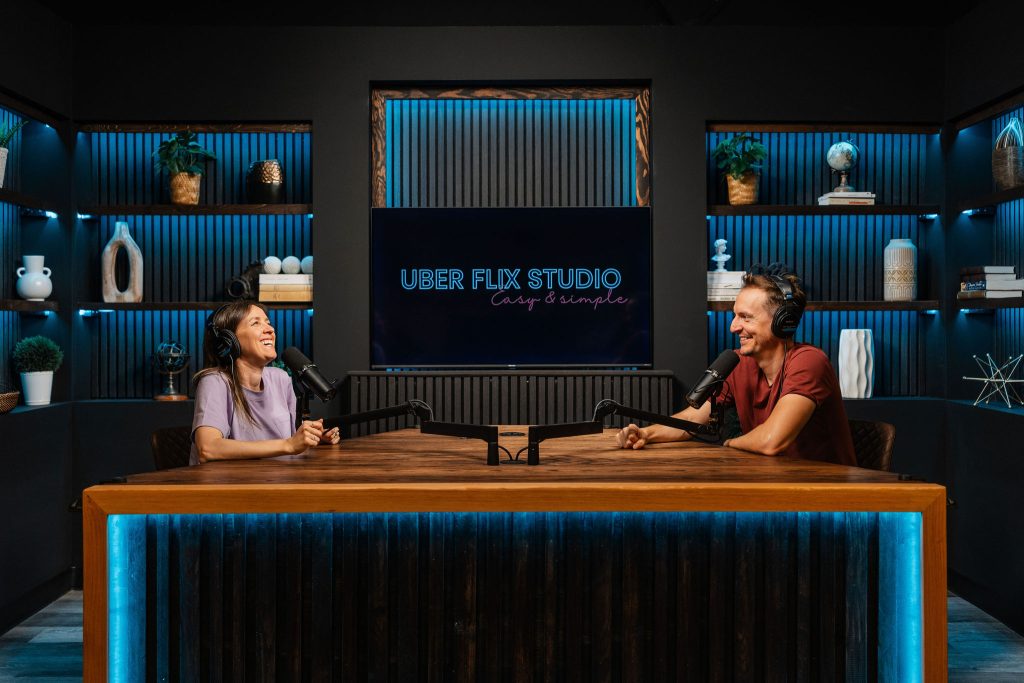

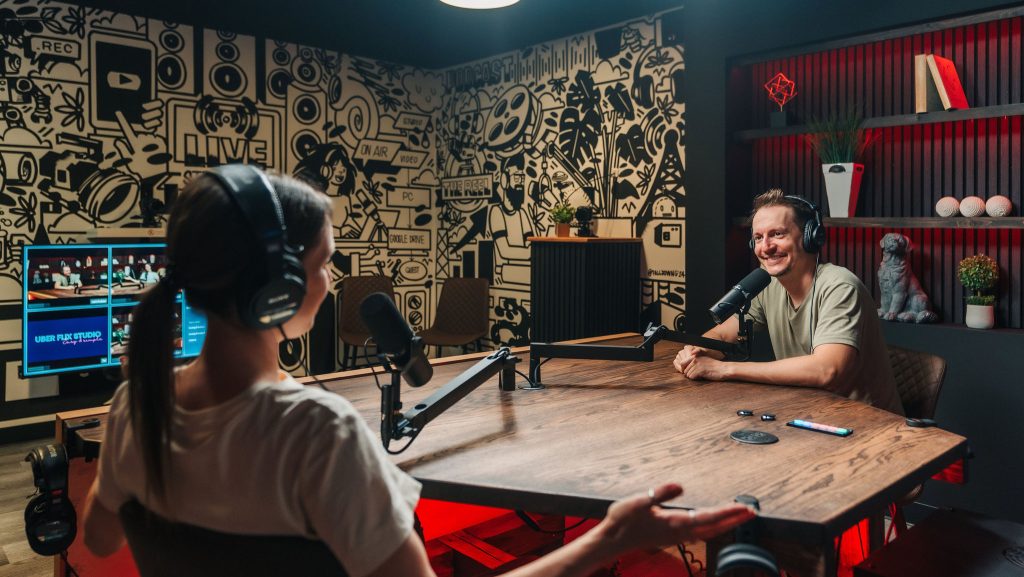
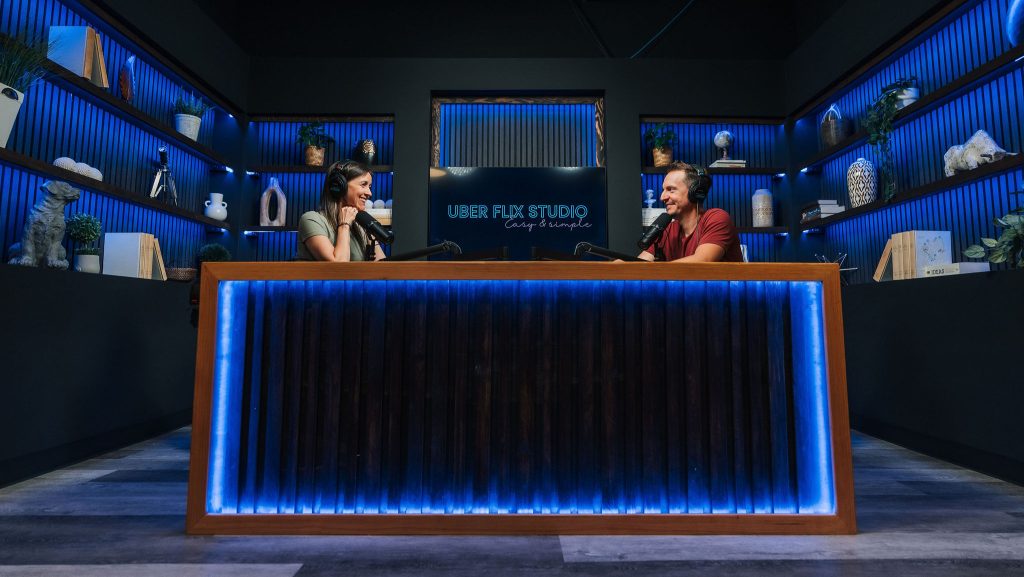


There are a few must-dos as well with it comes to templating. Clean auto-captions are essential. Whether there are single-word popping or full sentences, they need to be simple enough as to not be too distracting, but good enough to draw attention. After all: you are fighting for attention spans.
Helvetica: A classic and clean sans-serif font that is universally readable. It’s a safe choice for captions as it maintains clarity even at smaller sizes.
Montserrat: This geometric sans-serif font is modern and versatile, making it perfect for social media captions. It’s highly legible and has a bit more personality than Helvetica.
Arial: Another safe and commonly used sans-serif font, Arial is highly legible across all devices and platforms, making it an excellent choice for captions.
Roboto: Designed by Google, Roboto is a modern and highly legible sans-serif font that’s widely used in digital media, including social media captions. Its clean lines make it easy to read even in small sizes.
Open Sans: This humanist sans-serif font is known for its friendly and open appearance. It’s great for captions because it’s both readable and approachable.
Poppins: A modern and rounded sans-serif font, Poppins is visually appealing and easy to read. It works well for captions because of its balanced and clean look.
Lato: Lato offers a slightly softer feel compared to other sans-serif fonts. It’s still very readable and works well for captions due to its clarity and modern design.
Bebas Neue: If you’re looking for a more bold and impactful font, Bebas Neue is a strong option. It’s all caps and works well for emphasizing key points in captions.
Oswald: A reimagined version of the classic gothic style, Oswald is narrow and tall, making it a great choice for bold, attention-grabbing captions.
- Source Sans Pro: This open-source sans-serif font is designed for readability, making it a good choice for captions. Its clean and simple design ensures it remains legible on various screen sizes.
It’s important to create a schedule that includes the topics you’ll cover, the names of your guests, their contact information, and recording and tentative publishing dates. Maintaining a backlog of episodes ready to be released can be a lifesaver if you can’t produce content for several weeks. Additionally, set aside time or a budget to create reels from your episodes for social media. A well-made reel can easily attract new subscribers, making a noticeable difference quickly and in the long run. Here’s what you should include:
Conclusion
These practical tips will help you effectively prepare and launch your podcast. By following these steps, you’ll maximize your chances of success and be better equipped to produce engaging episodes that resonate with your audience. Best of luck with your new project!

Pierre Bussières is Editor of Uber Optimized, Director of Sales with JeemanGo Podcasts, and Editor in Chief of Hoppy History. He writes on alcohol markets, beer history, and disruptive technologies. He previously wrote for Global Risk Insights, the Diplomat, Reflets, La Montagne des Dieux, the NATO Association of Canada, Diplomatie, and Le Temps d’une Bière.

